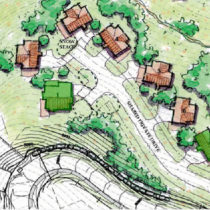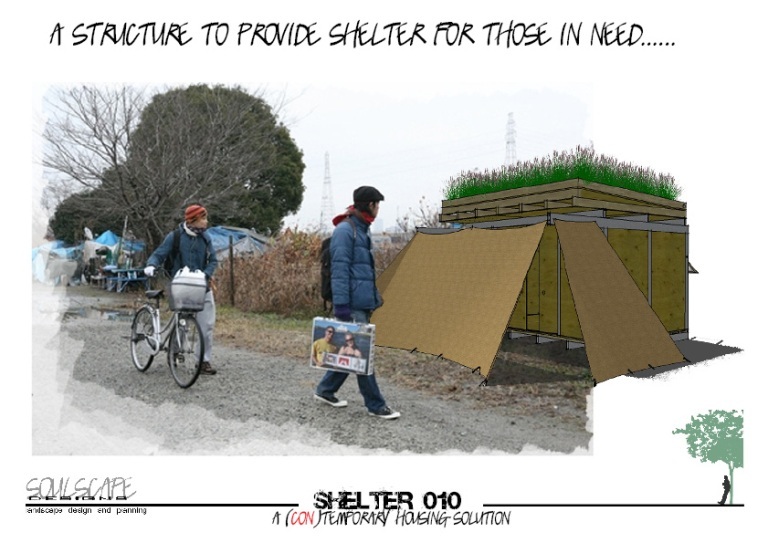Landscape Architecture for Landscape Architects › Forums › GENERAL DISCUSSION › Design for the homeless
- This topic has 1 reply, 13 voices, and was last updated 14 years, 4 months ago by
 Trace One.
Trace One.
-
AuthorPosts
-
July 20, 2011 at 11:17 pm #161371
 Laura KendrickParticipant
Laura KendrickParticipantI’m a rising 2nd year MLA student and am interested in lots of aspects of urban design, but one thing I’ve been wondering about is design specifically for the homeless. Does this happen? And as an important factor or just another little side consideration that might make it sound nice? I’ve come across a dissertation relating to homelessness, but I wonder if anyone’s aware of research, theory, or practice that’s current (I just saw a couple books in my school’s architecture library but they are from 1986 and 1990). Anyone actually working on this, with specific intent to address homelessness, actively in design work in cities?
July 20, 2011 at 11:40 pm #161407 Trace OneParticipant
Trace OneParticipantOMG, I am sorry, you sound so naive..Homelessness is a problem that cities, societies are working on constantly.I think Bloomburg just came out with something new LAST WEEK…For my city, Fresno, two years ago we cleared out a camp and it cost us $5,000 per homeless person when we were sued – who knows what the homeless will do with their checks..More recently, Fresno built 10×5′ ( substandard) shelters on a lot – a whole bunch of them – really – we built them, out of wood..crazy idea..
Our society is dealing continuously and in the eternal present with the homeless…Perhaps to know what is going on one would have to do some travelling and interviewing..A LOT is going on, it is constant, it is changing, and I think it will be for as long as we form groups and act as a society, we will deal with the homeless..
Just out of curiousity, what do YOU do for the homeless? I am not religious, do not go to church, so I placate some of my guilt by giving to every homelss person I encounter..To extremely varying results!!! Recently I have started to give away small bottles of wine – man do I get some good smiles from that – but it IS Fresno – the bums are pretty bad off and honest bums…In La Jolla, I found the bums had a much more complex relationship with accepting handouts, to say the least… You know that Mayor Koch had a real focus on the homeless of Manhattan, of course..So he ended up with one guy who pooped on his front stoop of his apartment building in Manhattan every morning..HA!
Any one else remember that story? Henry Cohen?
July 21, 2011 at 12:03 am #161406 Trace OneParticipant
Trace OneParticipantps,I was in love with my own brilliant design, turning shopping carts into fold-out shelters, and found through Land8 that the design had been detailed, in EDAH, I think – “Everyone Deserves a Home” – check it out..I also designed a homeless park to go with that, that included ‘roaming roads’ fresh water spots, etc. – hopefully to accomodate their needs..
It is an intractable problem, and a good one to tackle – we need new ideas, the solution has not been found..But there IS a LOT of past to learn about! Something that I personally value, although not everyone does..
July 21, 2011 at 4:08 am #161405 Laura KendrickParticipant
Laura KendrickParticipantWell, I’m sure this may, at first glance, sound defensive and rude, but thanks for apparently assuming I don’t know anything. Of course homelessness is a constant problem in many, if not all, cities. I didn’t mean is anyone, anywhere doing anything about homelessness. I meant are landscape architects (and I probably should include those in allied fields too since we all often seem to work together) doing things in their designs to specifically reflect and/or deal with the realities of homelessness. Because it’s not as if there are as many articles about this topic as there are about stormwater mitigation. But perhaps my first post wasn’t well articulated, and that’s my fault, so I’ll try to explain more of what I was trying to get at originally.
Opening up the question to the whole field of solutions to homelessness would be a huge endeavor. I just wanted to know about LAs in particular. Which means that I’d like to hear more about your (TraceOne) shopping carts that can become shelters–sounds cool. Anyway, I don’t think that landscape architecture can “solve” homelessness (but perhaps we can take part in a solution?); the problem is way bigger than just designing public space, of course. I guess I should have asked things more like: are there things we can to do to mitigate the negativities of being homeless; do designers actively consider the needs of the homeless in urban designs; what are the positives/negatives/implications of that approach? And of course the answers will vary based on the cities and their individual issues.
Not that I claim to have no naivety, so perhaps some of the points I will bring up next will reveal some, but part of why I posted is because, philosophically, I’m interested in the notion of homeless as a “problem” in the first place. (Consider the ideas of Daniel Quinn in “My Ishmael”, especially in terms of nomadic peoples, although the only nomadic culture still extant that I’ve heard come up recently is the Irish travellers.) Yes, homeless people sometimes steal, use drugs, poop on the stairs of Mayors, etc, but that’s not quite what I mean in terms of it being a problem. I find it interesting that many people seem to be obsessed with the idea that owning a home or wanting to own a home is the only way (or the best way) to live in this country. (And perhaps that another whole story for another post. On a social work website.) I wonder what would happen, how cities would change, if public spaces would be noticeably different if public opinion wasn’t that living without a home was a problem that needed “fixing”.
On another tack, and one more in line with my original impetus for posting, was the fact that, as far as I can recall learning or reading about in recent years, people who are undereducated, mentally ill, and/or are GLBT youth comprise a disproportionately high amount of the homeless population. Which is part of why LA obviously cannot be the only solution–and maybe can’t even be a large portion of a solution–because providing quality education, giving proper and effective care to those with mental illness, and keeping bigoted parents from kicking their GLBT kids out of the house are not things LA deals with directly. But can LA, in some way, assuage the crap that those lacking a home, especially for the aforementioned reasons, deal with daily? For that matter, can design change people’s minds? Mostly in the sense of the fear of/disgust with/pitying of homeless people. LA might not be able even to do a small bit of assuaging alone–it would be prudent, I imagine, for those within the social services, educational, economic, and political arenas that deal most directly with homelessness, to be consulted. Likely it’s pie-in-the-sky, but could there be public space that offers services to the homeless and provides the comforts and conveniences to the regularly-housed that so many already strive to include in their urban park designs? Put another way, could an urban space provide for the homeless the things they need, without compromising its other functions, whether it’s envisioned as an interim ‘solution’ to help the homeless while social service and other programs get worked out–funding, paperwork/bureaucracy, all manner of reasons homeless people don’t get services/program they might need to help them get basics needs met–or seen as more permanent? (And on the ‘more permanent’ side of the question, I’m thinking about how design could possibly address this sort of thing, while ignoring–for the time being–the fact that I’m sure cities/citizens would be up in arms about ‘why do homeless people get a “free house” paid for by the city, they should just get a job and a house like “everyone else” ‘. I simply wonder how LAs/design firms would consider this in their process if they weren’t being hounded by political pressure and the “fact” that I just mentioned ignoring for the exercise of this question.)
So maybe I am naive. Or maybe I’m trying to come up with new ideas, such as are referred to in the second response to my post. It just would be so much more welcoming, as a relative newcomer to LA and this website, to be greeted with intriguing or probing questions or comments (no, I don’t “do anything” for the homeless, in the typical sense of that notion; I’m a grad student living off loans with no money to give to any charity, and I’m going into LA, not social work–so instead I’m trying to “do something” by considering the issue as it relates to the field of my interest, even to wonder, if I was homeless, what would I want, especially if the programs in my area were such that there was no end to my homelessness in sight? And even “crazier,” what would I want if I chose to be homeless–perhaps here I should say nomadic?–or, in fact, preferred it?), rather than to be assumed to be a simpleton wondering if anyone wants to help homeless people. As you can see, there’s a lot going into my thought process about this, and I’m sure it was overkill to explain everything I have; perhaps I should not have assumed I could clearly explain my question, thereby eliciting the type of answers I’m interested in without saying more myself to begin with. Basically, I just wanted to know about things like the ‘roaming roads’ and to open up a discussion for those likewise interested. If anyone’s still with me after this long ramble, thanks for considering my thoughts!
July 21, 2011 at 5:40 am #161404 Jonathon MartinezParticipant
Jonathon MartinezParticipantOh yes Trace, everyone is naive and stupid, and you are so brilliant, creative, enlightened, and generous.
July 21, 2011 at 5:58 am #161403 Jason T. RadiceParticipant
Jason T. RadiceParticipantAlso, the only LA I know that has actively designed for the inclusion of the homeless is Walter Hood with one of his Oakland projetcs. Most LAs try to keep the homeless out of their designs. Municipalities do not want to spend hundreds of thousands of dollars on a project for their benefit. Besides, that money could be put to much better use actually providing a service to get the homeless off the street.
July 21, 2011 at 10:12 am #161402 Trace OneParticipant
Trace OneParticipantI think we have been through this argument before, Jason – I disagree, the homeless are often thought of in designs…Olmstead did it. As long as the design is ‘democratic’ (for all) with public water, benches and public bathrooms it will be used by the homeless..Of course, some people have chosen to lock up the parks – the disclusion of the public is a whole other way to approach this subject – I think this has proliferated recently, and gave a paper at CELA on the design of a ‘boardwalk’ that involved high fences, separating humans like a zoo..barrier design is more the way we are going these days, was my idea..
Sorry to be so rude, Laura, it just pushed one of my buttons where I see Americans having so little facts at their disposal and so often turn towards coming up with something new, rather than learning from the past..We specialize, as a society, in imagination, we do not specialize in reality, it seems to me, and listening to Congress these days, or Rupert Murdoch, really makes me tired of that…
That said, homelessness is nothing I ever pursued as an academic investigation, so I know nothing of literature on ths subject. Perhaps that is where work needs to be done – documentation and research.
If one looks into the actions of local planning boards, of cities, one would find the absolute gamut of ideas has been tried. Yes, many homeless are schizophrenic..Yes, why not just let them roam, give them a chance to be who they are..San Francisco and LA are famous for that – I think both provided homeless areas where they were allowed to exist, undisturbed..(in the past…I don’t know if that is still going on…) I imagine if you would investigate Dutch approaches to homelessness, one would find similar approaches..
and I don’t see why Landscape Architects would not be considered part of every decision that has been made on benches, on public water, on public bathrooms – a lot of LA’s work in planning..
As long as we have our parks open and usable, they are for the homeless..Because when is the transition made from the lost backpacker to the permanent resident.. Like I said, JK Rowlings was homeless, as we know..I have spent many nights in parks or in train stations across the world…
I apologize again for my absolute rudeness..there was no excuse, and it is a good topic..
July 21, 2011 at 10:15 am #161401 Trace OneParticipant
Trace OneParticipantno, jonathan, just opinionated and rude..
July 21, 2011 at 10:53 am #161400 Trace OneParticipant
Trace OneParticipantdid you google ‘homelessness’ and ‘ design for the homeless’ ? Tons of stuff..
July 21, 2011 at 4:03 pm #161399 Mara RamosParticipant
Mara RamosParticipantLaura, you can design for the homeless every time you get involved in the design of a public space. The hardest part is to put yourself in their shoes, and you’re already doing that. Also, you don’t have to actively involve any institution, department, or anyone else in the process if you feel they will impede the the process rather that help/support you/the ’cause’. Each time you make a design decision, you can make a contribution, big or small. There will always be external stress, which is unavoidable, and for various reasons, as it is expected in any project. But there is always the possibility of low key impact. I’m also a MLA second year student , but I’ve been an architect for 9 years now and my favorite thing about this profession (MLA specifically) is the possibilities when it comes to public space and the impact it has in as many areas as we want to include… it is so inclusive in that sense.
I know you were talking about the macro aspect of the issue and how we approach it as a society, but in the mean time, we can do our part, even if small, in our own projects.
July 21, 2011 at 4:07 pm #161398 Andrew SpieringParticipant
Andrew SpieringParticipantCheck out this project by a Land8 member… http://land8lounge.com/photo/albums/design-it-shelter-competition
July 21, 2011 at 5:16 pm #161397 earthworkerParticipant
earthworkerParticipantWhere’s the discussion about homeless landscape architects who have been destroyed by this putrid economy? Even a ‘rising’ LA student better have a backup plan for finding a job in this industry a few years from now.
July 21, 2011 at 6:12 pm #161396 Leslie B WagleParticipant
Leslie B WagleParticipantThe only really current reference I can offer on this is coverage given (link below) to the gradual development of an urban walking greenway loop where one segment involved an area with a homeless camp. I don’t think there is any “federal legislation” that gives such campers some kind of squatter’s rights to halt a facility for other people from being built, but the City involved did some coordinating with them and found sources of assistance. It pretty much seems from the article below like they relocated peacefully.
http://www.news-record.com/content/2010/03/05/article/in_the_city_s_path
As far as LA’s, I don’t know if any were involved, but consultants would have to take their marching orders from the municipality. It would be one thing to discover such camps or individuals during surveys, etc. and ask the client or managing department what emphasis to give, and to offer design responses….but I don’t think consultants are usually in the “driver’s seat” on the issue, or would last very long if engaged in a philosophical conflict with the local governmental client. As others have pointed out, solutions would involve social services and would probably turn out as unique in format as in any other human political+physical design interface problem.
July 21, 2011 at 7:34 pm #161395 Trace OneParticipant
Trace OneParticipantJason, you can choose your television channels, but not your own facts.
http://www.nationalhomeless.org/index.html
I sure wouldn’t want to be one of the 1.3 million homeless children and run into your “nasty brutish and short’ view of human existence.
But more to the point, I don’t believe the statistics bear your survival of the fittest perspective..see link..it is one of many..
Oh, and I don’t know about Central Park, but Prospect Park was for the masses. It was for sleeping outside when your Brooklyn tenements were too hot..Olmstead felt we all would learn from the nature that previously only the rich could experience. As the grandaughter of a Polish immigrant who had a grocery store in Brooklyn (East New York) the park was theirs, they adored it.. Along with good old Coney Island….
July 21, 2011 at 7:40 pm #161394 Trace OneParticipant
Trace OneParticipantand as Henry says below, the Veterans comprise a significant portion of the homeless…..I met many viet nam vets living on the streets of Brooklyn in the eighties, warped by their drug use during the war..Used to play Frisbee Golf with one of them, he would appear from the shrubberies of Prospect Park, ready for a game..
-
AuthorPosts
- You must be logged in to reply to this topic.



